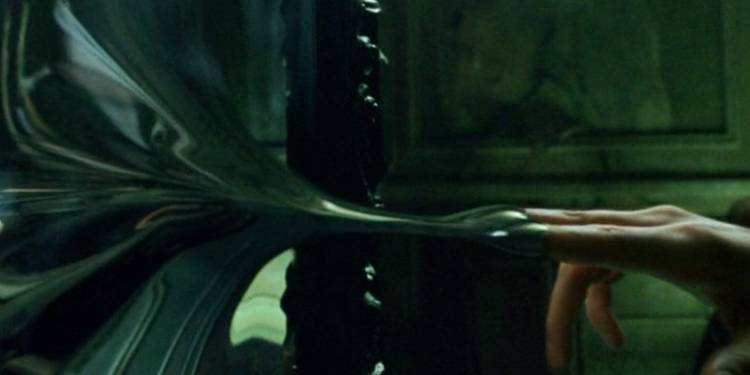As I was finishing my post about the decentralized nature of narrative, I began to see the connections between rhizo narrative and Timothy Morton's concept of hyperobjects. In this post, I intend to explore those connections to see what emerges.
Morton begins his 2013 book Hyperobjects by defining hyperobjects as "things that are massively distributed in time and space relative to humans" (location 104, Kindle edition). He provides some examples such as the Florida Everglades, all the styrofoam ever produced, and the solar system. These are big things, and they fit quite nicely with the prefix hyper, but they unfortunately suggest that hyperobjects must be big relative to humans. Bigger is, of course, one shade of meaning for hyper, but not the only one. I prefer beyond. Hyperobjects recede beyond us both into the infinitely large and into the infinitesimally small, into the past, through the now, and into the future. Thus, a quark is as much a hyperobject as is a solar system.
And this fits better, I think, with Morton's object oriented ontology (OOO) which suggests, among other things, that no object ever fully reveals itself at any one time to any other object, including us humans. Full disclosure appears not to be part of the universal order, if OOO is correct. Thus, all objects are hyper, including stories.
Fortunately, Morton provides us with some characteristics of hyperobjects that can aid our thinking about this slippery concept:
- Viscosity
- Nonlocality
- Temporal Undulation
- Phasing
- Interobjectivity
Of course, as a hyperobject itself, the concept hyperobject does not exhaustively reveal itself with these five characteristics, but we can begin to find some handholds and landmarks that can help us understand this concept.
Viscosity is all about entanglement. In his blog Ecology without Nature, Morton says of viscosity, "the more you know about a hyperobject, the more entangled with it you realize you already are." Hyperobjects engage us skin to skin, breath to breath. Sometimes they rape us, sometimes they make love, but mostly they are just around us like air that we don't notice until it moves … or stops. Air is a viscous hyperobject pressing in, around, and into us at all times.
Trump's 2020 Stolen Election story is a viscous hyperobject. Not on the same scale as air, perhaps, but it shares the same kind of viscosity as air. Whether you accept the story or not, the story is always already there wherever you are, rattling at you from beneath some rock, buzzing at you through the ether, on your smartphone, by the breakroom, in your dreams. You cannot escape it. If you manage to forget it for awhile, you will be suddenly reminded of it in an overheard conversation in a restaurant, and you realize that while you were distracted the story was still circulating, resonating through the social and political ecosystems. Like Harry Potter or a garden weed, it appears like magic, already realized, as large as Hagrid. The story is rhizomatic.
When you first heard the story, it was already there. It was already there for Trump, assuming he might have been the first to tell this particular version of the story, but the story was already there: a deserving, blessed hero (usually a man, in this case, Trump) is denied his just rewards by an evil character or cabal (the antagonist, in this case the Deep State and/or Democrats) against which he will wage holy war and win. You know this story and have told it yourself, perhaps many times in countless iterations. The narrative is always already there.
The very large hyperobjects force us to realize that we are within the object and the object is within us. There is no exterior, only interior. The only way to experience the story is inside the story inside us. We have no vantage point outside the story from which to analyze it. The scientific, objective point of view is a psychological trick we use to keep reality at a distance from us, to keep from being overwhelmed by the massive black holes pressing in from all sides and imploding within our guts. The objective point of view seems to work at times, but life — its energies, materials, information, and organizational strategies, its stories — interpenetrate us, tying us together. We are a knot in a web, a crossroads, and when the knot unravels, we cease.
The concept of hyperobjects, as introduced by Timothy Morton, offers a useful lens through which to examine the complex and pervasive nature of narrative. By understanding stories as hyperobjects, we recognize their immense scale, temporal depth, and inescapable influence. Like the air we breathe, narratives are viscous, entangled in our lives, shaping our perceptions and actions. The Trump 2020 election story, for instance, or the Trump as Cyrus story serve as potent examples of a hyperobject narrative, demonstrating its ability to permeate our consciousness and resist containment, regardless of whether or not we believe the stories. As we delve deeper into the characteristics of hyperobjects, we will uncover how this framework illuminates the rhizomatic structure of narratives and challenges traditional notions of authorship, objectivity, and linear progression. In subsequent posts, we will explore the remaining characteristics of hyperobjects—nonlocality, temporal undulation, phasing, and interobjectivity—to further unpack the implications for narrative theory and practice. By examining how these qualities manifest in storytelling, we can gain a more nuanced understanding of how narratives shape our world and how we, in turn, shape them. Ultimately, this exploration will invite us to reconsider the boundaries between storyteller and audience, between fiction and reality, and between the past, present, and future.
No comments:
Post a Comment